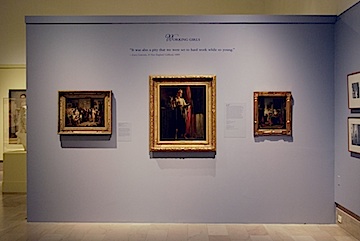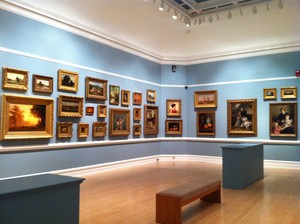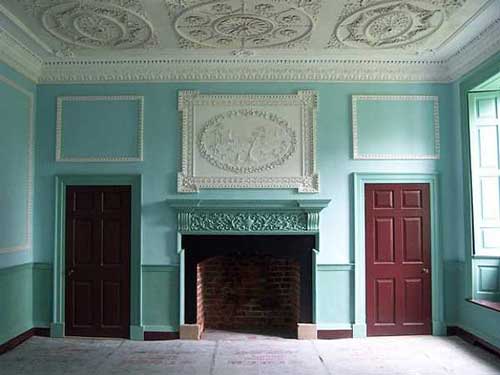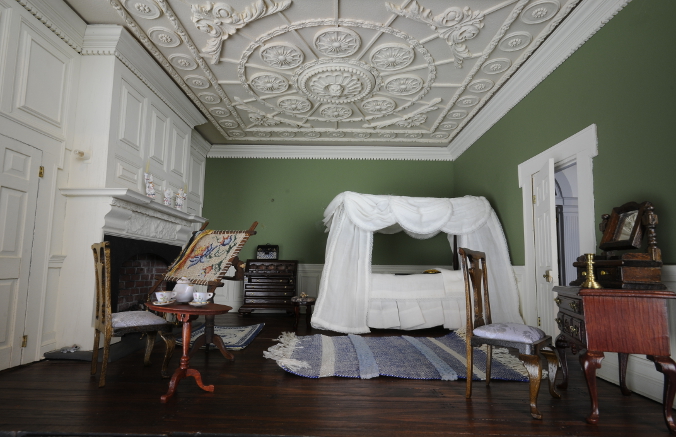
This is a list of the museums where I have worked. All have different perspectives, art types, and periods of art. All of these experiences are vividly part of my study in art history; they have me reflecting on the past and how far back these experiences have linked me to my love of art.
1. George Walter Vincent Smith Museum of Art
This was the museum where I interned as a student in the Department of Art History at the University of Massachusetts (UMASS-Amherst). This art museum holds the eclectic collections of George Walter Vincent Smith (1832-1923) and his wife, Belle Townsley Smith (1845-1928), in an Italian palazzo-style building established in 1896. It's a museum that could speak to us if it could...and maybe it does Haunted Springfield.
One of my fellow graduate colleagues, Janet Gelman, was the Education Curator. We immediately bonded as we shared our affinity for children's art education: she was in the museum setting, and I had an elementary art teacher background. We had long talks over coffee or sandwiches. Inevitably, the children's theme slipped into what Professors had thrown at us. Graduate school is a world unto itself. Long papers, research, sleepless nights, critiques that didn't go so well. Both of us were old enough to take things in stride and move on. The younger students admired our "c'est la vie" attitude regarding our studies.
The George Walter Vincent Smith Museum is a gem among museums.
It is part of "The Quadrangle" in Springfield, Massachusetts.
Among the varied themes of the George Walter Vincent Smith Museum are:
Vast holdings include one of the largest collections of Chinese cloisonné outside of Asia.
Japanese Arms and Armor
Tiffany Stained Glass windows
19th-century Middle Eastern carpets
Hasbro Games Art Discovery Center for children's classes
American Paintings Salon
What a blessing to have had this experience at a museum near where I was born. This building is a museum's museum: the eighteenth-century ambiance, the long halls and grand paintings upon paintings, and the eyes of antiquity all around = my definition of heaven.
2. The Porter-Phelps-Huntington House Museum

I worked at this museum while I was a graduate student at UMASS-Amherst. My role was curator and docent, and I loved this job. I lived just down the road in Hadley, Massachusetts, and the director, Susan Lisk, became a close friend when I worked there.
What a history this house has. For a detailed background, consider Forty-Acres: The Story of the Bishop Huntington House
This unique museum has a magnificent history. As a docent, I often toured a small party through the house, and the "one-hour tour" became two.
This well-preserved 18th-century house was continuously occupied by a single family in 1752 until the death of Dr. James Lincoln Huntington, the museum's founder. The house contains many interesting items belonging to the family and preserved for over 300 years. The Porter-Phelps-Huntington papers are now preserved at Amherst College Archives and Special Collections.
My memories of this museum are distinct since so many families occupied the house. There are also references to supernatural events dating back to the Huntington years. You can check some of the tales here: "Ghost" Stories.
I had my encounter. I was doing some curator tasks in the Director's home. Back in the day of electric typewriters, when errors needed to be changed in the text, I found myself putting back a pencil that rolled off the desk. And then, again. And then, again. I started to freak out because I sensed that "someone" was in the room. It was eerie.
Suffice it to say this is a beautiful museum, and if you are ever in the Hadley, MA, area, it's worth planning a tour. TripAdvisor
3. Yale Center for British Art

How could I have been so lucky to land a position at this beautiful museum? Well, luck and a heads-up from a fellow student in the Art History department. She graduated a semester before I did and had been in the Photograph Cataloguer role at the BAC (British Art Center) but was leaving for another museum. I applied for this position and interviewed with the head of the Yale Photograph Archive department, author Anne-Marie Logan. Soon I was headed to New Haven, CT to work at this prestigious museum.
The internationally acclaimed American architect Louis I. Kahn (1901–1974) designed it to house Paul Mellon's (Yale College, Class of 1929; 1907–1999) extraordinary gift to Yale University. It was the first museum in the United States to incorporate retail shops in its design.

The geometrical four-floor interior is designed around two interior courtyards and comprises a restrained palette of natural materials, including travertine marble, white oak, concrete, and Belgian linen. Kahn succeeded in creating intimate galleries where one can view objects in diffused natural light. He wanted to allow in as much daylight as possible, with artificial illumination used only on dark days or in the evening. The building’s design, materials, and skylit rooms combine to provide an environment for the works of art that is simple and dignified.
4. The Pardee-Morris House
Again, one thing leads to another in my life. After I got the job at Yale, I needed a place to live. It turns out that Susan Lisk of the Porter-Phelps-Huntington House (see above) had a sister, Linda, who lived in New Haven, Connecticut, and she spent a whole day with me checking the rentals in the city. I found a lovely place with daily public transportation to downtown. Linda also suggested that I might want to docent at this house museum for a little extra income. Who would have thought it? Two sisters who have been part of my museum adventures.
One of New Haven’s oldest structures, this historic property descended in one family through seven generations.

This beautiful house, dating to 1680, is a rare example of a stone ender. The ell was added around 1767. On July 5, 1779, during the Revolutionary War, the British raided New Haven and burned the house. Using the surviving stone and timbers, Captain Amos Morris rebuilt the home the following year.
In 1915, William Pardee bought and restored the house,

In 1918, William S. Pardee, a descendant of the Morris family, bequeathed the property to the New Haven Colony Historical Society, which is today known as the New Haven Museum.
The oldest portions of the house are believed to date to the late 17th century, probably during the lifetime of Thomas Morris, the first colonial grantee of land in this area, or one of his sons. It was partially burned by the British in 1779. It remained with the Morris family until 1915, when it was sold to William Pardee. He briefly occupied the house and willed it to the historical society upon his death a few years later, along with an endowment for its care.
My time here was primarily on weekends. I was the only docent and had to open and close the property during the tourist season. This, too, was a property with a lot of history and a fun building to present to curious visitors. During this period (the late 1980s), the future of this museum was risky and uncertain.

How happy I am to see that the New Haven Museum bought the structure and now has summer concerts on the lawn. This has brought new life to the museum and joy to the visitors.
5. Kenmore Foundation
I traveled to Virginia to see my sister during my years at Yale. She quietly planned a gathering at her home and invited a few friends, including an invitation to the bachelor who had built a house across the street. Soon after, this man asked me to marry him, and I said, "Yes."
I moved to Virginia in 1989 and have lived there since then. Not wanting to give up on my love of museums, I learned about Kenmore Plantation in Fredericksburg, Virginia.

My role began at Kenmore as a docent. I loved it! I have an affinity for welcoming visitors and telling the stories of the objects and people who lived there. The other volunteers, most older than I, were helpful and guided my early start. Not many months later, I began to work with the Education Director, Stacia Gregory Norman, and I helped catalog the photographs and papers. In my second year, W. Vernon Edenfield took notice and offered me the position of Education Assistant.
Kenmore is the Fredericksburg home of Revolutionary War patriot Col. Fielding Lewis and his wife, Elizabeth "Betty" Washington, George Washington's only sister. In Kenmore's spacious interior, the plaster designs on the 12-foot-high ceilings combine baroque, neoclassical, and rococo elements. Use arrows to slide:
My days at these museums are long gone, but they are not forgotten. I gained knowledge, insight, and history and have met amazing people. I am grateful for the opportunities that these experiences provided.
For those with the notion that museums are places for the "haunting," here are some books:
Pin it, please, or comment below this post.



















































